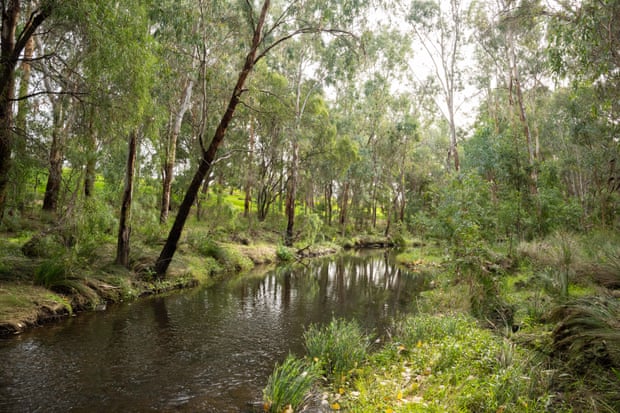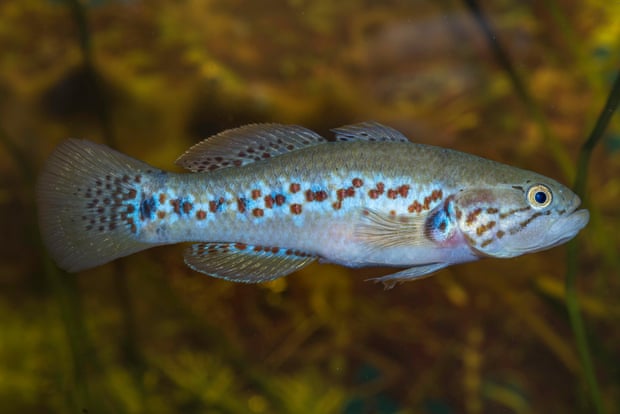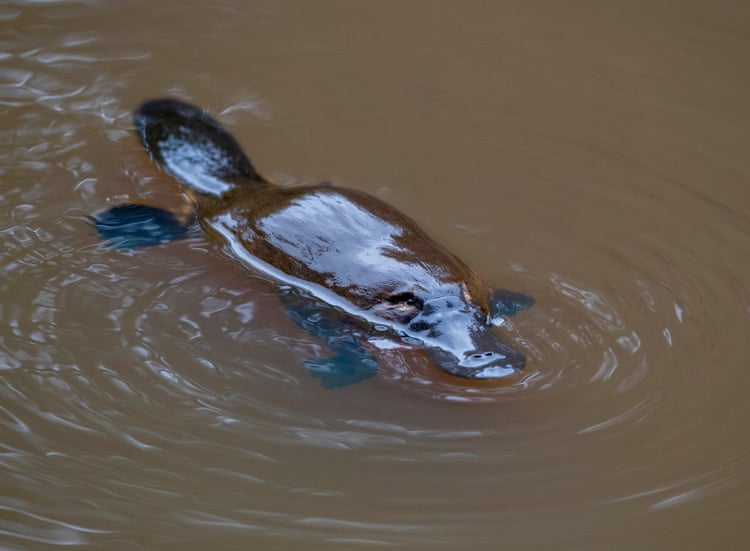In May 1872, Adelaide’s doctors were surveyed about the “noxious effluvia” emanating from the River Torrens, the South Australian Advertiser reported. John Burn wrote to the paper to say he endorsed their condemnation of “the filthy state of Adelaide – a city of stenches”.
“If any of our citizens be sceptical, I would suggest his taking a stroll along King William Street on to the Morphett Street Bridge, where he might tarry a wee bit for the inhalation of the horridly pestiferous vapours there to be enjoyed,” Burn wrote.

The last sighting of a platypus in the Torrens was recorded little more than a decade later – it was declared extinct on the South Australian mainland in the 1970s.
But now there are plans to reintroduce the elusive monotreme to the city’s river, which has been extensively rehabilitated in recent decades.
The purple-spotted gudgeon, touted as a canary in the coalmine for platypus habitats, has already been reintroduced and is thriving.
It is hoped the platypuses will join them within a couple of years.
Prof Chris Daniels is the presiding board member of Green Adelaide, the statutory body in charge of the project. He says the river was so badly degraded it would be impossible to return the habitat to its original form, as other rewilding schemes might attempt.
“We’ve got a different situation,” he says. “The Torrens was always very difficult to manage. When Adelaide grew around it we effectively destroyed it.”
It was called the city of stenches in the 19th century because “it was so poor at managing its sewage”, Daniels says.
Sewage farms alleviated the stink but the Torrens kept going downhill.
“They were dealing with flooding, pollution, the creation of a dam, erratic flows, stormwater … [it was] ecologically destroyed,” Daniels says.
“It had been completely massacred by the 1960s.”
Restoring the river
But over the past 20 years the Torrens, an 85km stretch from the hills to the sea, has been rehabilitated through waste management, better management of water flows, wetlands, revegetation and the reconstruction of creeks.
With the urban river “completely reformed”, Daniels says, conservationists wanted to know if they could bring back its “premier animal”, the platypus (Ornithorhynchus anatinus), which is also an “umbrella animal” that can improve the ecosystem for other natives.

A scoping study released in July looked at water depth, quality and temperature, protection from predators including cats, foxes and dogs, availability of food sources such as yabbies, prawns, shrimp and small fish, whether the banks were good for burrow-building, and so on.
It wasn’t perfect. Some sections are better than others. The study recommended some improvements. But it’s possible, the experts say.
Daniels is confident they will overcome all the obstacles.
There is plenty of food, he says, and the purple-spotted gudgeon – a “kind of platypus-lite” that uses the same habitat – was successfully reintroduced to the Torrens in November after a century of absence.
“In my Walter Mitty moments I do imagine that you’re somewhere on the river … you’re walking your dog – on a lead – in the early morning, just at sunrise … down into the water you’ll suddenly see rings appear and then up will pop this little brown thing,” he says.
“It’ll be very active, buzzing along the surface, then it’ll dive down again … it’ll drag its head and face through the stones looking for mayfly larvae and little prawns and yabbies and things like that.

“Then it’ll pop to the surface again. If you’re really lucky, you’ll see it pop out, look around, then scoot into a hole in the roots of a river red gum. That’s its burrow. It might be in there with several puggles.”
‘How the hell did I get here?’
David Cobbold knows the joy of platypus spotting. He and his partner, Narelle MacPherson, run the Warrawong wildlife sanctury in Mylor, south-east of the city, and they spotted one the first time a real estate agent took them on a tour.
“Every time I see one I pinch myself,” he says. Cobbold is bewildered at his journey from an arts and law graduate in Tasmania.
“I am some bumbling fool from Hobart who ended up with 42 acres of the most insane Australian paradise,” he says. “And whenever I see a platypus I think ‘how the hell did I get here?’”

Warrawong has three underwater observatories and unfinished breeding facilities that need external investment to complete. Cobbold says the occasional platypus escapee can be spotted nearby but likely ends up as fox food.
“The more successful we are, the bigger the problem gets, in that we are in a confined space,” he says. He would welcome being a part of the Torrens plan.
A wild population on Kangaroo Island, where the platypus was introduced in the 1920s, may be one source for reintroduction to the Torrens.
But the state environment minister, Susan Close, says she expects Warrawong will be involved in discussions once they get to the logistics of breeding and moving the platypuses.

Close says what she loves about the project is “what that says about what we’re capable of doing”.
We hear about the extinction crisis, about climate change, she says, but the platypus means saying to people “you can turn things around”.
“We have fixed the Torrens, not perfectly, not entirely, but to the point experts are saying we can reintroduce the platypus,” Close says.
“It’s a story that says there’s hope, and that’s worth more than the story itself.”
This article by Tory Shepherd was first published by The Guardian on 24 December 2023. Lead Image: A platypus at the Warrawong wildlife sanctuary in South Australia. Photograph: Adrian Mann.
What you can do
Help to save wildlife by donating as little as $1 – It only takes a minute.

Leave a Reply